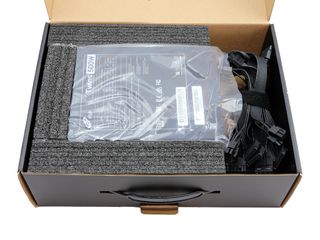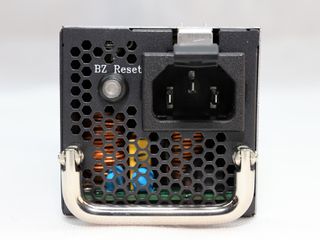FSP Twins 500W Redundant PSU Review
The FSP Twins series combines the usability of a normal ATX PSU and the advanced features of a redundant server unit. The Twins 500W we're evaluating today addresses users that need an ultra-reliable PSU and are willing to pay for it.
Why you can trust Tom's Hardware
Packaging, Contents, Exterior, And Cabling
Packaging










The box is quite large, and on its front is a picture of the frame and both modules. There's an 80 PLUS Gold badge near the bottom-left corner, along with a five-year warranty icon. On the opposite side, one of three icons describes an interesting feature: the digital controllers that the frame and power modules are equipped with.
On the back, two tables depict the frame's power specifications with the modules installed, along with the modules' specs (they only have +12V and 5VSB outputs). Underneath is a features list that claims this PSU is ideal for mail, Web, or home servers. Moreover, FSP mentions its Guardian software, which monitors vital aspects of the PSU in real time and keeps logs of up to seven days of use. Finally, a useful diagram depicts all available connectors, though it's missing cable lengths.
Contents


Inside the packaging are two smaller boxes containing the frame and both power modules.


Here's the box with the power modules.

The frame is protected adequately by packing foam.


The accessories box contains a small folded paper that serves as the user's manual, two sets of screws, a pair of power cables, a FDD adapter cable, a USB header male-to-USB male adapter, and a bracket.
Exterior



Here is one of the power modules. Two are needed for the frame to operate properly.


The module's cooling fan is small but powerful. It makes a lot of noise at high speeds, but thankfully the fan control circuit doesn't push it hard very often.


One of these two photos depicts the power specifications label.

In addition to the AC receptacle up front, there's also an illuminated push-button that's used to reset each module in case the frame's alarm is activated.


Inside the frame, you'll find the DC-DC converters responsible for generating the minor rails, along with the circuit that regulates -12V output.

On the bottom of the frame, a large sticker includes a power specifications table.


There is a plastic grommet around the cable exit hole protecting the cables from the chassis' edges.


It would be ideal if the modules were equipped with power switches.
Cabling







All cables are flat and consist of darkened wires. The 24-pin ATX connector mainly uses 16-gauge wires, so it's quite rigid and will probably complicate the cable routing and installation process.
Current page: Packaging, Contents, Exterior, And Cabling
Prev Page FSP Twins 500W Redudant Power Supply Review Next Page A Look Inside And Component AnalysisStay on the Cutting Edge
Join the experts who read Tom's Hardware for the inside track on enthusiast PC tech news — and have for over 25 years. We'll send breaking news and in-depth reviews of CPUs, GPUs, AI, maker hardware and more straight to your inbox.
Aris Mpitziopoulos is a Contributing Editor at Tom's Hardware US, covering PSUs.
-
shrapnel_indie ReplyPros
Full power at 45°CAll cables are fixed, and because this is a server-like product, its maximum operating temperature for continuous full power delivery is 50°C.
Please explain to me why these numbers don't seem to match up properly. (THB, I may have missed it.)
-
dstarr3 I really wonder what a consumer could possibly want this for. What is an ordinary consumer doing that they absolutely cannot risk any downtime whatsoever on their rig?Reply -
nzalog I know freenas can be configured to work faster if you can for sure trust the system from not having RAM errors (covered by ECC) and if you can guarantee there is no unexpected shutdown (covered by dual power and ups). However the reliable power is not really required because a SSD as an SLOG device will cover for it, but then the SSD becomes the bottleneck for writes.Reply -
firefoxx04 I build several file servers a month for clients. Low end enough to where pre built solutions are not an option. This power supply would be a good fit but it is useless, imo, without some sort of email alert option. Maybe I missed that?Reply
When I deploy file servers for clients, I always setup some sort of alert system for raid failures so I can fix the problem. What is the point of redundancy if the user has no idea a problem has occurred? Yes i know that this PSU makes a "loud buzzer noise" but I cant have that either. The user needs to continue to use the system and they cannot if it is screaming 100% of the time.
Send me an email alert. Its easy to implement. -
Rookie_MIB One thing I'm curious about - what if one unit does fail? Are they bog-standard replacement parts where you can go and buy a similar hot swap redundant power supply or is the system proprietary. If it's the latter, then I don't see many people lining up for this one...Reply -
apache_lives A PSU is but one part of a "reliable" machine, to me this will not increase up time or do anything of any value, seems more like a "makes me feel better" part.Reply -
Aris_Mp about the first comment, the PSU is certified for up to 50C ambient full power delivery, but I choose to test up to 45C every PSU that passed from my test bench (since I also have to evaluate 40C rated units and I need to keep the same conditions for all).Reply -
shrapnel_indie Reply19144735 said:about the first comment, the PSU is certified for up to 50C ambient full power delivery, but I choose to test up to 45C every PSU that passed from my test bench (since I also have to evaluate 40C rated units and I need to keep the same conditions for all).
While I'm glad for that, It's also nice to know if a unit rated at 50°C operation will deliver on its "promise" though. (If you exceed the "promised" rating, like the 40°C rated units @ 45, well, it delivered on its promise and then some.)
-
Pompompaihn Newegg has several server chassis for sale that come WITH redundant 500w+ PSUs for less money than just this power supply. Given that the market is low end commercial/prosumer, and it's not going to be for gaming or HTPC, why wouldn't you just buy the whole thing for cheaper?Reply